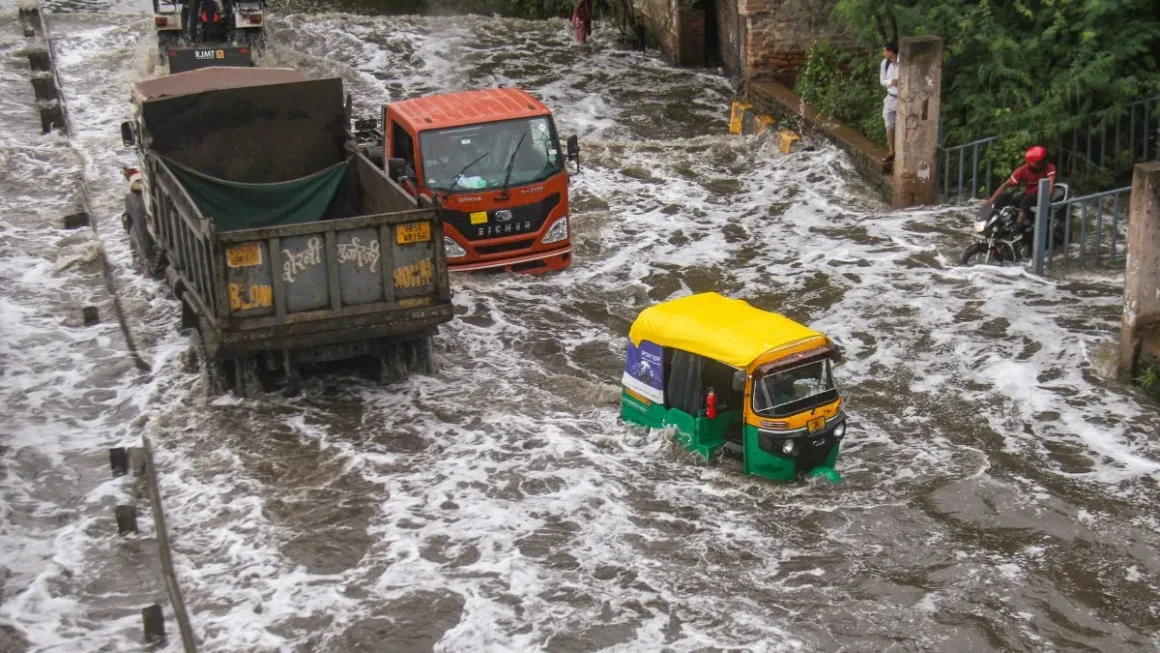Why Gurgaon Floods: Monsoon Waterlogging Facts, Figures, and Missed Fixes
In yet another reminder of the city’s fragile drainage infrastructure, Gurgaon witnessed 133mm of rainfall in just 24 hours (July 9–10), leading to massive waterlogging across Golf Course Extension, Sohna Road, and Cyber City approach roads.
Viral videos showed SUVs floating near Vatika Chowk, delivery workers pushing bikes through waist-deep water, and office-goers stranded for hours, highlighting a grim reality: Gurgaon, despite crores spent, continues to sink with each heavy downpour.

When Gurgaon Became Venice, Again
Gurgaon’s July 9–10, 2025 downpour (133mm in 24 hours) turned “millennium city” into a flooded mess, with roads resembling streams and basements under water. Viral videos showed SUVs half-submerged on Golf Course Extension and delivery workers wading through waist-deep water.
And it’s not a one-off event:
- 2022: 82mm in a day, heavy waterlogging near NH-48 and HUDA City Centre.
- 2023: 110mm on July 8, flooding Basai and Sohna Road.
- 2024: 97mm on July 10, leading to water entering homes in Sector 56.
Yet, each year, drainage plans remain on paper while Gurgaon sinks under the first heavy spell.
Why Does Gurgaon Flood Every Monsoon?
The problem isn’t just heavy rain but Gurgaon’s inability to handle it. Over the past decade:
A GMDA audit (2024) reveals a 35% population growth since 2015, but drainage capacity has increased by only 12%. Green cover has shrunk from 9% in 2010 to less than 4% in 2025, reducing natural rainwater absorption.
Despite ₹520 crore spent on drainage over a decade, a May 2025 RTI revealed that 42% of drains were not desilted before monsoon, explaining why even 70mm rainfall turns key roads into pools.
It’s Not Just Gurgaon: Waterlogging Across Key Indian Cities
Gurgaon’s flooding isn’t an isolated disaster. Other major Indian cities mirror similar waterlogging chaos, underscoring a national urban crisis amplified by climate change.
Mumbai: Heavy Rains, Heavier Disruption
Mumbai, which received over 200mm in a single day last monsoon, sees local train delays, flooded underpasses, and knee-deep water in Dadar, Sion, and Hindmata each year. Despite advanced pumping stations, encroachment on floodplains and concrete-heavy planning reduce water absorption, mirroring Gurgaon’s struggles.
Bengaluru: The Silicon Valley’s Drainage Woes
Bengaluru, once known for its interconnected lakes, now faces:
- Waterlogging at Outer Ring Road and Bellandur during moderate rain.
- Encroachments and blocked drains, flooding tech park routes, and delaying commutes.
- Rising damage to homes and offices, much like Gurgaon’s Cyber City area.
Pune: Expansion Without Planning
Pune witnesses flooding in Pashan, Kothrud, and parts of Baner during heavy spells. Rapid urbanization and drain encroachments lead to road collapses and traffic snarls, even with rainfall volumes lower than Mumbai or Gurgaon.
What’s Fueling This Pan-India Flooding Crisis?
Across Gurgaon, Mumbai, Bengaluru, and Pune, common patterns emerge:
- Rapid, unplanned construction.
- Loss of green cover and natural drainage paths.
- Outdated drainage systems built on old rainfall patterns.
- Increased short, intense rain bursts due to climate change.
The India Meteorological Department reports a 17% increase in heavy rainfall days in NCR over 15 years, a trend visible across urban India, overwhelming drainage systems designed for the past, not the present.
Counting the Costs: Lives, Livelihoods, and Economy
In Gurgaon alone:
- Over 180 schools shifted online during flooding.
- Offices reported up to 35% absenteeism during peak waterlogging.
- Delivery workers lost daily earnings, while water damage claims with insurers rose 27% in 2024, with 2025 likely to exceed this figure.
- Stagnant water increases post-monsoon health risks with rising dengue and malaria cases.
The Missed Fixes: Why Drains Stay Blocked
For years, Gurgaon’s authorities have claimed they’re working to solve the city’s flooding nightmare. The numbers, on paper, sound promising:
- ₹520 crore has been allocated and reportedly spent on drainage upgrades and desilting drives since 2015.
- 24 major drainage projects have been announced across the city in the past five years.
But here’s where the story falls apart:
- Out of those 24 projects, only 9 have been fully completed, leaving critical sectors still waiting for relief.
- Coordination gaps between GMDA (Gurugram Metropolitan Development Authority), MCG (Municipal Corporation of Gurugram), and HUDA (Haryana Urban Development Authority) stall progress, creating overlaps and bureaucratic delays.
- An RTI filed in May 2025 revealed that 42% of Gurgaon’s drains had not been desilted before the monsoon, despite the allocated budget, directly contributing to blockages during heavy rain.
- Key waterlogging hotspots like NH-48, Sohna Road, and Subhash Chowk continue to flood even with moderate rainfall (50–70mm), highlighting that paper budgets are not translating into ground-level outcomes.
Despite the crores spent, Gurgaon’s drainage systems remain under-capacity, poorly maintained, and largely reactive, forcing residents to endure the same flooding cycle each monsoon.
What Gurgaon (and Other Cities) Need to Do Before the Next Downpour
Flooding is no longer an anomaly but a seasonal certainty. Gurgaon and similar cities can adopt practical, scalable solutions:
FAQs
How much rain did Gurgaon get on July 9–10, 2025?
133mm in 24 hours, triggering heavy waterlogging.
Is Gurgaon’s flooding linked to climate change?
Yes, with more frequent and intense rain bursts overwhelming outdated drainage systems.
Which other cities face similar waterlogging issues?
Mumbai, Bengaluru, and Pune regularly face urban flooding due to unplanned growth and drainage limitations.
FOR MORE BLOGS – beyondthepunchlines.com

 Add to favorites
Add to favorites








